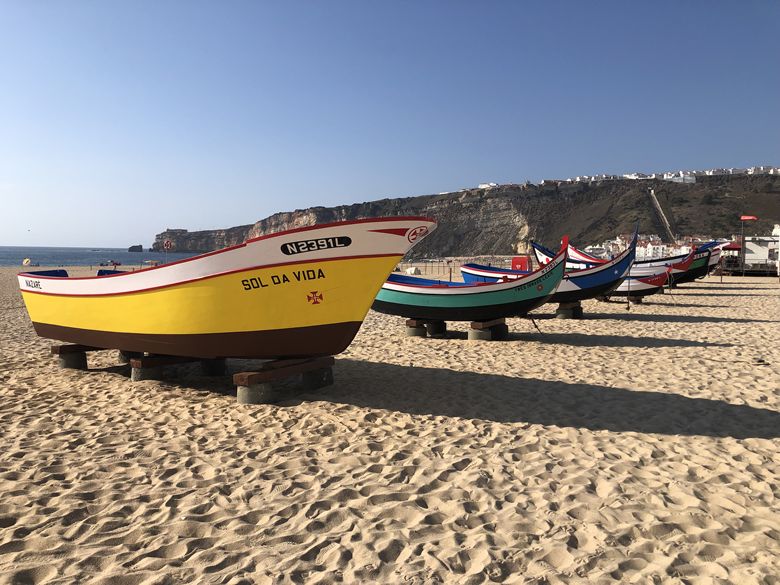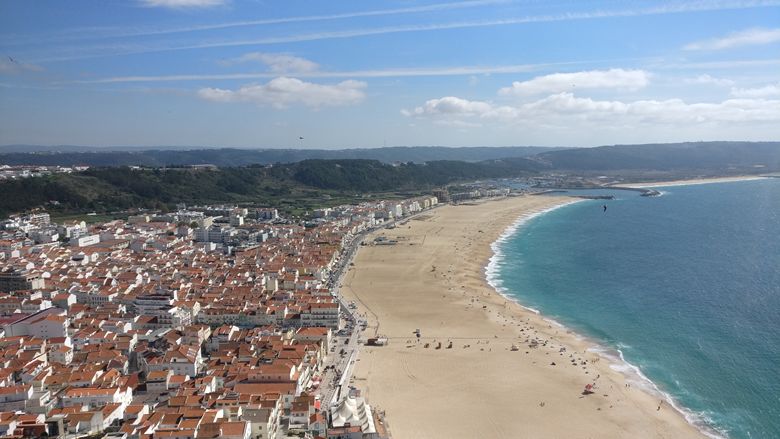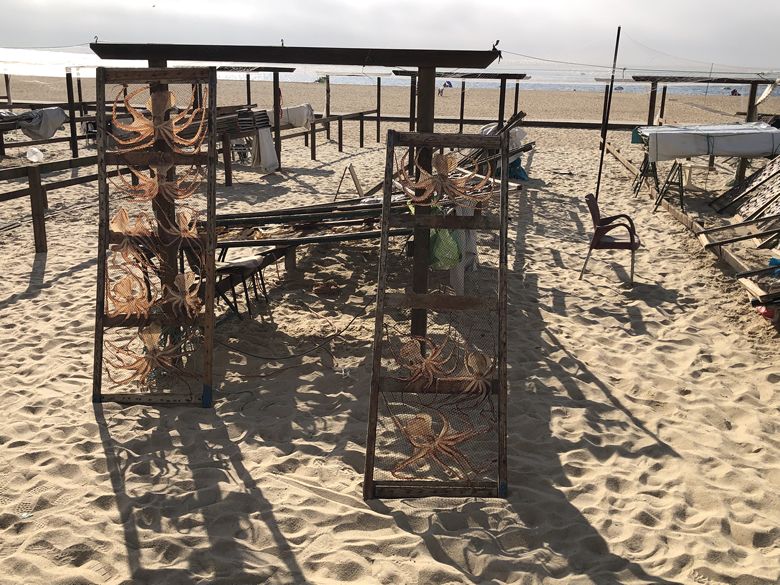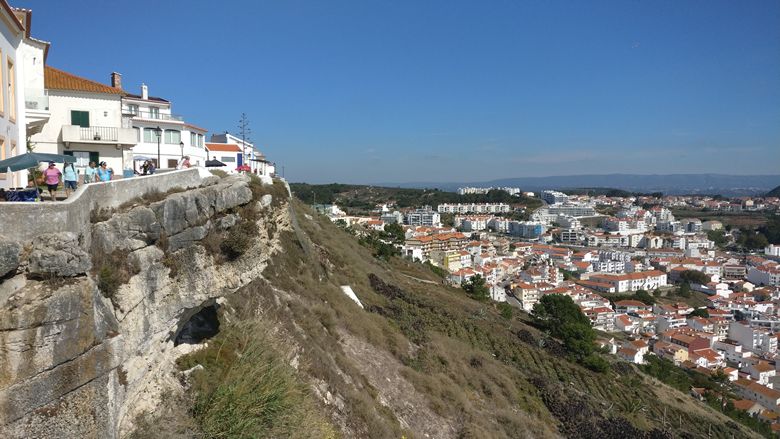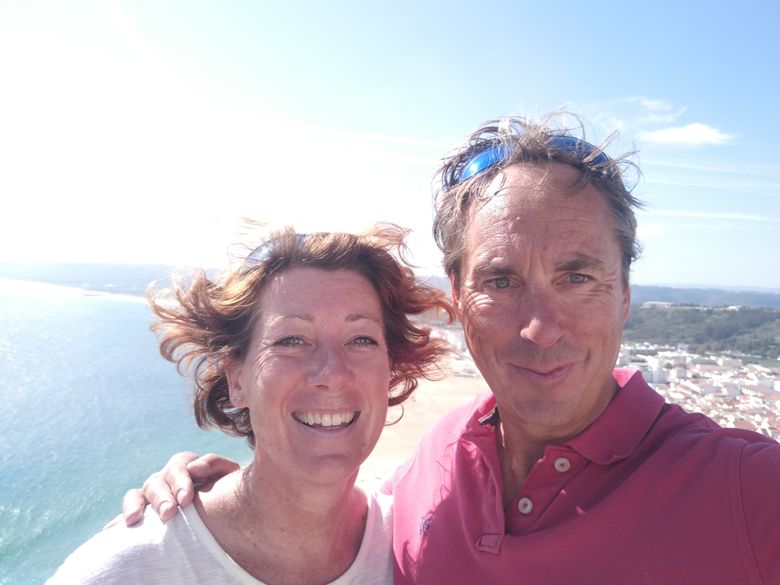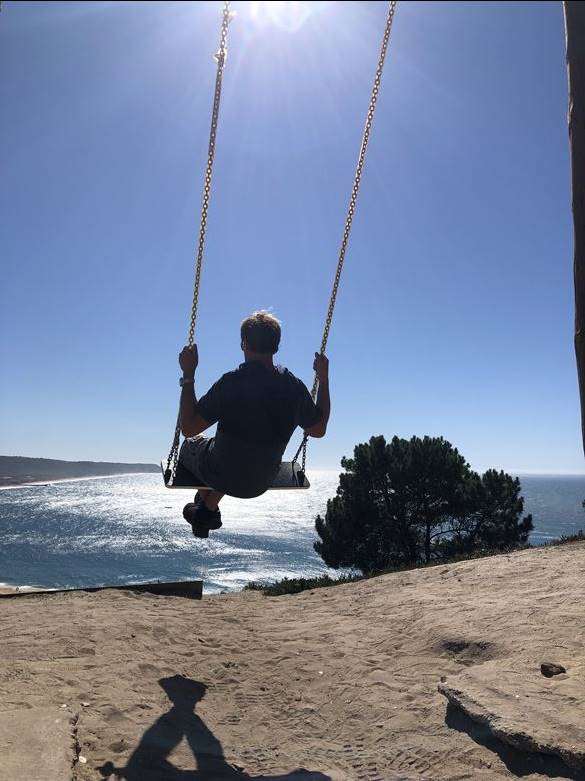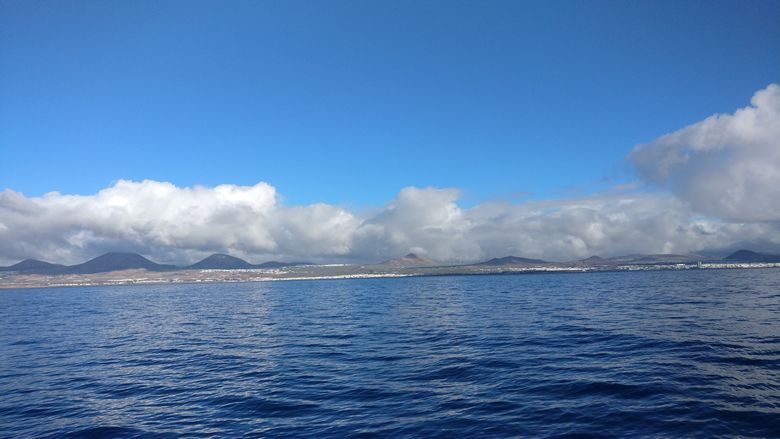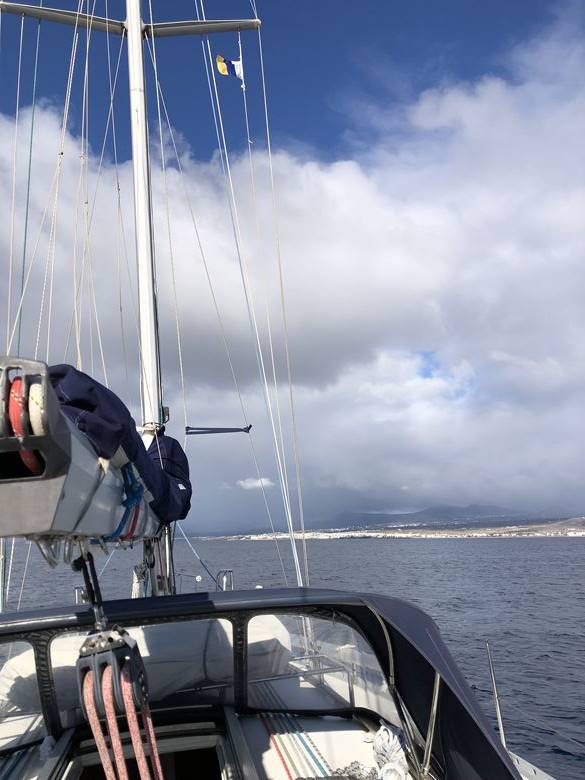Nazaré, Portugal and passage to Lanzarote, Canary Islands 28:55. 0 N 13:42.0 W

Nazaré, Portugal and passage to Lanzarote, Canary Islands We know it’s been a while since our last blog, our reasons were spending too much time mulling over our next passage and destination whilst enjoying being in Nazaré. We did spent a lot more time in Nazaré than we initially thought and as my mind was generally focussed on our next passage I’ll leave the mate to describe our time there.
Traditional fishing boats
Looking south towards the marina Nazaré is a holiday destination on the Silver Coast. After several weeks of trying, and failing, to get to grips with Portuguese it was a welcome change to see (and hear) things in various different languages! The marina is at the southern end of the town, then the main touristy bit along the beach to the north of it, the old town (Sitio) up a hill to the north of this, and then Praia do Norte (big wave surf beach) to the north of this. The marina staff were fluent in Portuguese, English and French and we enjoyed having ever changing international neighbours. Our closest marina neighbour had a very familiar accent and turned out to be from Bolton – small world! He had retired to Portugal and settled in a village to the south of Nazaré. Since I had recently decanted the last of the first mega bag of Yorkshire tea bags into the galley tea caddy, Skip has been a little on edge. After dealing with the pleasantries he asked (hopefully only I could hear the desperation) “where can you get good tea bags?” Apparently proper tea bags are worth more than gold to ex-pats. If only we had known! (*note to any visitors J). The beach front is lined with restaurants, bars, ice cream shops (only in Portugal can you enjoy egg flavoured ice cream – it was great!) and shops selling tourist tat including anything made from cork – place mats, hats, bags and even shoes.
Great octopus drying weather! In contrast, on the beach is the Dry Fish Museum. This is a ‘living museum’ whose main purpose consists of preserving the ancestral tradition of drying fish in the sand. Ladies in traditional dress sit and display their wares with a backdrop of drying (and very aromatic!) fish. Access to Sitio is either by the funicular or by sweating up the hill in the heat of the day. You can guess which option we went with – we did feel virtuous (and paused at the swing to enjoy the view) and treated ourselves to a descent via funicular.
At the top of the sweaty hill
The easier way to Sitio
Skip relaxes to enjoy the view From Sitio we headed to the surf museum within the Fort de Sao Miguel. The walls of the museum are lined with the surf boards of brave (and a little crazy) people who have surfed the massive waves of Praia do Norte. The largest wave ever surfed was here in October 2020 when German surfer Sebastian Steudtner rode a 26.21m wave!! I can’t embed a video here but Google it – amazing! An added extra is the Kitty Village just outside the marina – this enclave provides des res accommodation (in the form of polystyrene fish boxes) for at least 10 cats/kittens. Each kitty has its own house (fiercely defended) and food and water are provided. Often people arrive with Peperami treats and surprise deliveries of mega sacks of dried food so the cats enjoy just enough human interaction, but not too much! After walking past the spa at the southern end of the beach least twice a day, my time in Nazaré was rounded off with a long and relaxing massage. The perfect way to prep my body for the gruelling passage ahead! Over to Skip for more on that… Passage to Lanzarote A few days before we left Nazaré, a couple of British boats, a Dutch boat and a Swedish single hander pulled into the marina. With the exception of the Swedish boat, the others had all been sailing in company down the Spanish coast and knew each other quite well. I went along to say hello and we all started chatting about the next passage – where everyone was heading and so on… The Swedish chap was next to us in the marina. I instinctively liked him and, getting to know him, discovered that he was a fellow member of the Ocean Cruising Club. He’d also sailed with our mutual friends in the Indian Ocean (a place not to be taken lightly – strong wind and strong currents). The other boats were aiming to leave Nazaré, the coming Wednesday 5th October. The reasoning behind this was there was no wind at all before then. Most of them were heading over to Porto Santo. We, however, decided to miss the Madeira Islands and head direct for the Canaries so we could spend more time there. Although I agreed that the GRIB files (weather data focussing on wind and swell) looked OK for Wednesday, I had an issue in that every time you looked at the latest GRIB, the forecast changed – significantly. Checking the synoptic charts for the North Atlantic showed a vigorous depression heading towards Cornwall (where else?!). This depression was the remnants of hurricane Gaston which had battered a bit of the US. The issue seemed to be that the wind from this depression was causing increased wind in the Portuguese trades and the swell, travelling many uninterrupted miles, was building with it. I have my rules as far as I can uphold them, which generally state: No running ahead of a storm; No long distances with changeable GRIBs; Leaving at least 24 hours after strong weather to allow the swell to die down. Chatting with the other boats, they all decided on leaving on Wednesday. Peer pressure was high, not only from them but from ourselves as the mate and I both knew we’d been too long in Nazaré and felt that it was time to leave. I checked and checked the GRIBs again and again, as one does. I noted that Wednesday and Thursday seemed to have little swell, however, something still wasn’t sitting quite right with me. I decided to ask our lovely Swedish neighbour PE (as he is called) for his input into my weather analysis. PE is a calm, experienced, retired professional chap and looking over the weather data together, he declared that Wednesday was an OK day to leave too. Damn, I thought, now even more peer pressure. I was up early on the Wednesday morning, re-checked the weather and went to wake up the mate as I decided it was a good time to head off. Most of the other boats had already left and PE was just leaving too. So, off we went, leaving Nazaré about 1030 in the morning. Ocean passage planning is never quite as simple as it would seem and this time we had an extra complication to deal with. Yes, Orcas! Whilst we were in Nazaré, a boat came in that had been attacked 20NM to the North. All the reports in the day or so before we left were concerned about daily attacks on boats to the south of Nazaré, all the way down to the Med. People in Cascais were even scared of leaving, it really wasn’t a great situation to be in. In fact, this is meant for anyone who may consider heading down this was way in the next year or two – it is only my opinion, but I personally would not sail this coast again until the Orca issue is resolved. As for us, Lanzarote is about 690NM from Nazaré – a good distance for sure, but that involves going the shortest route directly past Peniche, Cascais and Sines, i.e. the area where the Orcas were very active. We decided that the only sensible option would be head more or less due west from Nazaré, get across the continental shelf edge and into deep water as soon as possible. This would keep us more than 100NM off the Portuguese coast, but it would also elongate our distance by about 60NM, putting Lanzarote at some 750NM – a long passage by anyone’s standard. Many people, heading on a more direct route to Madeira, had fire crackers which they had bought in Spain (but were not for sale in Portugal). People who had used fire crackers did say that the Orcas left pretty soon afterwards. Other reports suggested shining a search light in the Orcas eyes etc etc. The mate, who is a marine mammal expert, may comment more on this, but to my mind, total lack of advice from any authority studying the matter will simply lead to people doing their own thing, enough said! Ourselves, we had the ship’s search light and a loud hand operated fog horn. We kept them to hand in the cockpit, probably more for our own sense of security as much as anything else. So, off we went. The first day was pretty good actually, not too much swell, good wind, full sail and good speed. I calculated that we’d be crossing the continental shelf by around 2300, which is on the mate’s watch. So, all well and at about 2100 I went off to bed leaving the mate in charge. I slept for maybe an hour or so, then became aware that the boat was rolling around a lot. In fact, it threw me from one side of the aft cabin to the other. Being tired, my first thought was “what on earth is the mate doing up there, maybe she’s got us beam on to the swell?” Too tired to go and look (the mate knows she has to wake me at the first sign of any trouble) I decided all must be OK and tried to sleep. At midnight, the mate came to make sure I’d be up for my watch and looking out, what did I see? The mate surfing along off the continental shelf, under full genoa (we’d doused the main before dark) at about 8knots plus! Goodness me, this was to be a fast passage! The mate went to bed, I sat on the helmsman’s seat looking at the chart plotter/MFD. We were indeed careering over the continental shelf and I assumed the swell, causing the rolling would die down once off the contours and in deep water. The wind, forecast to be 19 knots was actually up to 27 knots so some genoa had to be rolled away. We can do this alone without the need to wake up the off watch person, and I put two reefs in the sail, but we were still charging along. All I could do was set the boat at the best angle to the (now significant) swell and hope the mate would sleep OK. As we crossed the continental shelf, the swell remained with us, as did the wind. So where the GRIBs forecast 0.85m swell, we actually had about 3.5m at this stage, building to 5m later, with a period of about 8 seconds – exciting, but not dangerous. The wind remained about 25 knots, again, exciting but not dangerous, and so on we continued through the night… In the morning (day two) the mate was below and I was looking around. To my horror (and I mean it) I saw the unmistakable fin of an Orca. Then I saw it blow and jump. It was about 200m off the starboard bow. I have never moved as quickly in grabbing the fog horn and search light, I banged on the cockpit side to wake the mate (who continued to sleep happily). Very, very luckily, it seemed that this was a single Orca chasing prey (probably Tuna) which kept jumping out of the water ahead of it. After about 30 minutes I decided we must be in the clear and as our course of 220° true, kept us further and further away from the general Orca area our panic subsided into quiet anxiety. Whatever the boats in the thick of it, in Cascais and Sines would be thinking, I can only imagine. The next few days had us in a steady swell of sometimes up to 5m with winds between 20 and 25 knots. We made good speed and gybed over to point away from Madeira and towards the African coast. Meals were hit and miss affairs as no one could be down below for very long, if for no other reason we were being thrown around the cabin too much. Sleep was sporadic, but we stuck rigidly to our watch system. The nights were lively but moonlit and we saw little shipping. Only twice did I have to call a ship to clarify their intentions and to make sure we’d been seen. Despite all reports to the contrary, I am pleased to say that my VHF calls to both ships were answered almost immediately, in pretty good English and in both cases the ships altered course slightly to increase the CPA (less than 1NM is not good with a big sea running) – ships in the English channel, I hope you take note :) Day 5 saw us only about 80NM from Morocco with a good breeze and dying swell. We gybed again and aimed directly at Lanzarote, now only some 200NM distant, we even managed to get out my beloved sextant and take a noon sight. Pleased to be away from Orcas and in good conditions with the sun shining, we had one of the best afternoon sails of our lives. Towards the end of the day the breeze died and, knowing we had miles to go, we resorted to the engine, adjusting course and speed to be efficient for the boat and arrive in the morning of day 6, Tuesday 11th October. I had been once, as an instructor, to Puerto Calero and when we pulled in it looked just as nice as it had 12 years ago. Efficient, helpful staff and a clean and well-appointed marina were just what we needed after 750NM and 6 days at sea.
Land ho!
Closing in on Puerto Calero (note embarrassingly small Canary Islands courtesy flag – it was only €2.50!) I’ve a few things to sum up following what was quite a tough passage and the first such passage for us on Stargazer: Thanks to the mate who never missed a watch and who became more and more confident in her own sailing day after day. Thanks to Tim H (of Hamble) for a superb autopilot installation – impossible to do without. Thanks to previous owners of Stargazer, for installing a Duogen. A device that I wasn’t keen on at first, mainly because it looked a bit too cumbersome. However, after the first night at sea when it wasn’t deployed, our battery bank was down by about 65A. Deploying the Duogen had the batteries back up within a few hours and the dump resistors dumping excess power away – and all of this whilst powering the fridge, MFD, autopilot, lights, you name it… So much power was being dumped that we were looking around for other things to turn on! A superb piece of equipment. Thanks to Stargazer, of course, who took some pretty serious seas and seemed to absolutely relish it. A more classic hull shape is classic for a reason. In the words of a famous author – if you buy a modern boat for the extra 12” width leg room in the aft cabins, you’ll soon wish you hadn’t when you’re in a following sea. We were glad we were in an example of the former. Here’s the mate…. Wow, what a ride! I’m not sure what my expectations were for what was going to be my longest passage to date but it didn’t disappoint. Surprisingly, it didn’t take long on my first watch to realise that Stargazer was well and truly in her element, so I just needed to settle in too. We enjoyed moonlit and starry nights with phosphorescence in our wake, pods of Atlantic spotted dolphins bowriding, flying fish indicating we were in warmer waters, and (sadly) some dead baby squid on deck in the mornings that Skip returned to the water! They must have been attracted to the steaming light when we were under engine. Doing just about anything onboard was a challenge and it took over 24hrs after our arrival for me to get my land legs and be able to walk in a straight line again, and to remember how to move around the boat without clinging on! Now we’re here in Lanzarote, we’ll stay in Puerto Calero for a couple of weeks (enjoying being on holiday and sampling some of the many restaurants and bars that the marina has to offer *as budget allows, Skip…) and then move around to Rubicon. From Rubicon, we’ll head for the Cape Verdes, but that’s in a few weeks’ time. I’ll sign off with a Happy Birthday Daddy! Sorry we aren’t there to celebrate your Big Birthday in person, but look forward to seeing you virtually later on and raising a glass or two J LoL, J&Axxx |
